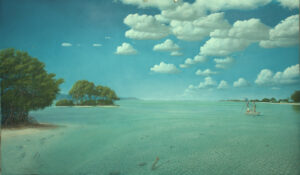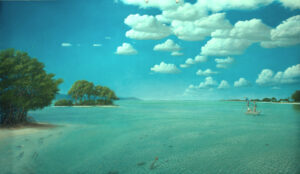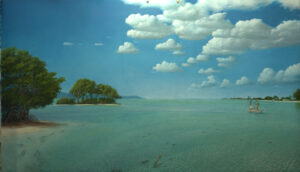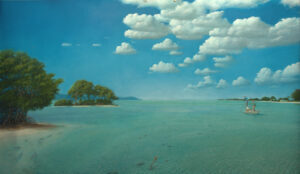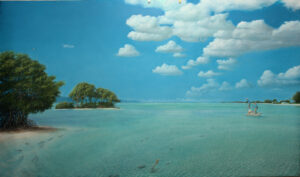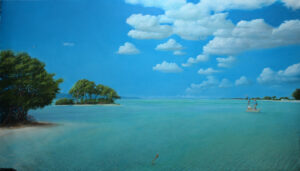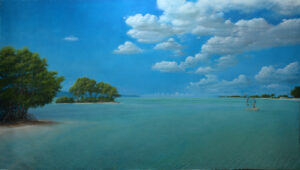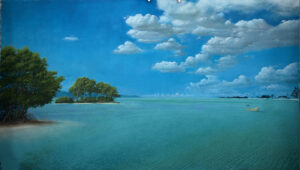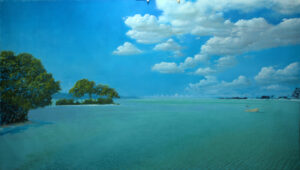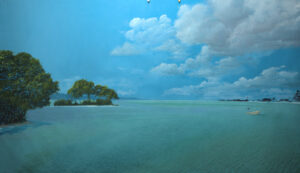Keith Cardnell: Finding Silver In Thin Water
Our complete archive of the documentation on English Artist Keith Cardnell's 'Finding Silver In Thin Water,' the artist's largest Sporting Art canvas ever created.
Keith Cardnell explains in his own words the various preparations and stages that contribute to the overall production of one of his masterpieces, as well as the materials used:
Normally the preparation of one of my canvases prior to painting can take up to 2 weeks. I will stretch my canvas over a plywood board stiffened with wood batons. I will then roller-in multiple layers of a colored ‘ground’ to remove the canvas weave and produce a texture that will provide ‘grip’ for the first paint layers. The drying process of the oil paint consumes the majority of the 2-week preparation. Following that, normally all of my paintings require at least six (and usually more) stages to complete in a period that often will be greater than 9 months. That said, the vast majority of that time will be spent visually examining the work to-date, trying to identify errors and short-comings.
Navigate through the menu below to read Keith's own words on the various preparations and materials used.
- The under-painting
- The blocking in
- Corrections to geometry, hue and tone
- First of a number of work-ups
- Work-ups(n). Numerous intermediate work-ups rectifying small errors and unifying the composition
- Final workup adding any points of maximum highlight and areas of deepest shadow.
Each ‘work-up’ will be a complete ‘pass’ of the entire canvas where every element gets paint or consideration. Work-ups consist of making small adjustments to geometry and hue and/or tone or identifying errors for the next pass. In any of these work-ups I also might scumble or glaze where I think it might be appropriate to a specific area or the entire work to assist in unifying the composition.
I have a large number of paints that I use regularly, but usually select a relatively small number for any particular canvas. I rarely apply ‘tube colors’ to a canvas, preferring to mix to get exactly the hue I want. For every painting I create, I will make several pre-mixed colors that I believe will predominate the composition. I overproduce these mixes to ensure they last until completion of a project and store them in medical syringes. This methodology ensures I don’t have to struggle to match colors mid-project and helps in the unification process of the last stages. All of my colors are artist quality Winsor & Newton oils. The following palette was used in this piece:
- Phthalo Turquoise
- French Ultramarine
- Cobalt Blue
- Cerulean Blue
- Sap Green
- Olive Green
- Winsor Yellow
- Naples Yellow
- Vermillion
- Vandyke Brown
- Raw Umber
- Raw Sienna
- Titanium White.
Please note I don’t use a tube black. I pre-mix two blacks: 1) Ultramarine and Raw Umber; and 2) Ultramarine and Vandyke Brown. One black tends to red whilst the other tends to blue.
My basic pre-mix top-layer for the piece was Phthalo Blue and Winsor Yellow. I created three tints of this by mixing in increasing amounts of Titanium White.
Tiny amounts of flesh tones were used from pre-mixes applied in portraits I have previously created.
My main stock of brushes are made again by Winsor & Newton. They are all long-handle ‘flats’ or ‘brights’ in all sizes. The two W&N brush series I use are now discontinued but I have a very large stock of both.
I also have a large stock of a single size, single series, flat sold by Jacksons Art Supplies.
The initial stages of my painting is on surfaces that have a very strong ‘tooth’ applied during the ‘weave removal’ process. This tears brushes apart so my first ‘brush applications’ are with a series that are very cheap and I can afford to discard after using. These are made by Royal and Langnickle.
Winsor & Newton
- Cotman, series 555, flats and brights, all manufactured sizes. Now discontinued.
- Galeria, flats and brights, all manufactured sizes. Believed discontinued but still available in small numbers.
Royal and Langnickle
- Long-handle oil and acrylic brushes sold in mixed packs of twelve. All rounds discarded.
Jacksons Art Supplies
- Shinku Synthetic, I only stock size 0
Purchased in 10 meter rolls - Russell and Chapple, Belgian Fine Oil Primed Linen
Finding Silver In Thin Water Updates
Stay up to date with the latest blog installments on Cardnell's masterpiece
Stage 07 – Tidying Up
This is it – the final stage of the Masterpiece; the culmination of nearly a year’s worth of patience, dedication, and precision. Cardnell: As well as numerous small adjustments to the picture, four significant alterations were applied to enhance. These are listed below, in tandem with the annotated image: To scale correctly, the thin-water ‘lattice’…
Stage 06.1 – Finishing the Sky
Cardnell: Prior to the annotated image, I did considerable work on the sky and A LOT of work on seabed highlights from the horizon to the beginning of the ‘lattices’. This general area is the most time-consuming, requiring the most brushstrokes per unit area. That said, it’s all looking pretty authentic as well as clean…
Stage 05.2 – Corrections & Enhancements
To the viewer’s eye, Cardnell’s Masterpiece very well could have been complete in Stage 05.1, or even Stage 04.3. To the master himself, however, there are two more stages to come before completion. The following two stages of infinitesimal perfections and details further illustrate Cardnell’s uncompromising dedication to the art, and solidify him as the…
Stage 05.1 – A Cloud Is Not Just A Cloud
Cardnell: I have had another run into 3am and then again more work this morning. Five thousand more micro brushstrokes into sea last night and around the area of the horizon. The work I’ve done on the clouds has really started to make them look as if they’re passing over your head. To most people,…
Stages 04.2 – Bringing The Seabed to Life; and 04.3 – “Laying Out The Pin-Sharp Seabed Highlights”
Bringing The Seabed to Life Cardnell: I now have 10 roughed in Bonefish swimming out from the bottom left hand corner of the canvas stretching upwards in a teardrop pattern to a line horizontal to the far edge of the sand of the first mangrove cluster. Whilst I’ve rendered the furthest Bones indistinct I’ve not yet…
Stage 04.1 – Bringing the Composition to Life
Another unique aspect to Cardnell’s approach to Sporting Art is the size at which he is willing to work. He is not afraid to create an image on a grand scale and feels, in doing so, he can bring the viewer into the image and make the viewer feel as if he or she is…
Stages 03.2 Cont’d – Graphite Angler & Guide Composition; and 03.3 – Explaining Seabed Details
Graphite Angler & Guide Composition Cardnell: Head buzzing so got up and started painting at about 2:30 AM. Now 4:30 AM here but I’ve just finished some research. FINALLY! Got the perfect stance on each player! I had a doze after my research and have now roughed-out a pencil study based on what I found.…
Stage 03.2 – More Clouds and Production Plan
More Clouds Cardnell: Please note that I have only worked on the clouds. I’m quite happy with the result so far. So much so that I expect Stage 04 to see this part of the composition complete. At the moment it is not my intention to add any more significant cloud-clusters but just to adjust…
Stage 03.1 – Reworking The Sky
The element of reality is as fundamental to Cardnell as the canvas is to the existence of a painting. That which would be seen in reality, especially in terms of linear perspective, is one of the many elements of a work over which the artist may study and deliberate for hours on end. This is…
Stage 02.3 – Moving on from The Seabed
Cardnell: After what must have been 20,000 brush strokes, I believe I’ve taken Stage 02 as far as I can and now will move on to Stage 03. As you can see in this Stage, I have taken the paint almost to the bottom of the left hand corner. This I have left un-overpainted while…

